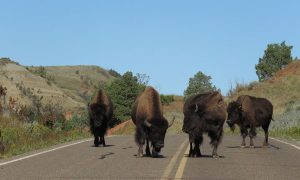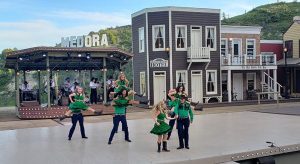 By Tim Trudell
By Tim Trudell
Freelance Writer
Roosevelt first visited the Dakota Territory in 1883 to hunt bison. He returned about a year later after losing both his wife and mother on the same day in 1884. His ranch was located about 35 miles north of Medora. He eventually returned to New York. His log cabin is located at the park’s visitors center.

Designated as a national park in 1947, Roosevelt National Park in southwest North Dakota consists of three sections – North Unit, Elkhorn Ranch Unit and South Unit. Visitors should plan to spend 2-3 days exploring the park.
While the Elkhorn Ranch Unit includes Roosevelt’s ranch, the North and South units attract thousands of visitors annually. The North Unit features a 14-mile drive along North Dakota’s badlands, while the South Unit – located just outside Medora – offers a 22-mile loop full of beautiful scenery and plenty of wildlife. With wild horses and bison herds roaming freely, as well as plenty of prairie dog villages, visitors are challenged not to encounter animals (always respect wild animals and give them space).

With the South Unit being the most popular section of Roosevelt National Park, a drive along the loop can take a full day, if you choose. However, people should plan to spend 2-3 hours to soak in the area’s beauty.
The loop includes several overlook spots, each with a unique view of the area. Some stops include short walking trails. While the trails can be uneven, none are too physically challenging to walk.
Park attractions include up-close visits to the prairie dog communities. Visitors aren’t allowed inside the villages, but they’re close enough for great views.
While prairie dogs may have a reputation of being invasive creatures, watching them move about and socialize is as educational as it is entertaining. Standing guard outside burrows, prairie dogs stand tall, constantly surveying the area for safety concerns. At the first sign of concern, a series of barks, reminiscent of chirps, are sounded. The communication is entertaining by itself, with it being almost song-like.
If a threat is imminent, prairie dogs pop inside the burrows, entering a system of tunnels connecting the community. As predators such as snakes and foxes try to enter a hole, prairie dogs viciously defend their turf.
As bison – also known as American buffalo – roam the park, its fairly likely visitors will have an opportunity to view the majestic animal. It’s critical to remember they’re wild animals and shouldn’t be approached. It’s best to watch their movements from the safety of a vehicle. Bison are also found in the North Unit.

Wild horses are abundant at the national park, and it’s common to find some walking along the side of the road. Horses come in various colors, with each beautiful against the backdrop of the landscape. Don’t approach them, as they may become agitated and strike with their hoofs. Horses will signal discomfort by moving their tails.
Roosevelt National Park is also home to other wildlife, such as pronghorn, white-tailed and mule deer, and elk, as well as coyotes. Prairie rattlesnakes are the one venomous snake found at the national park.
The North Unit’s 14-mile scenic drive features close encounters with the North Dakota’s badlands, barren rock formations dating back to the days when the state was part of a prehistoric sea.

Plan at least 90 minutes to drive the scenic route, beginning at the bottom of the Badlands and winding to Oxbow Outlook, with it incredible views. Oxbow Outlook marks the end of the road in the park. Follow the scenic drive back to the park’s exit. Along the way to Oxbow, visit River Bend Outlook, with its impressive scenery.
The North Unit also includes accessible trails for hikers of all levels. More challenging paths include Buckhorn, Caprock Coulee and Achenbach trails. Backcountry hikers need to obtain a permit for overnight hiking.

While Theodore National Park remains the primary draw, Medora offers a variety of charming attractions, including the North Dakota Cowboy Hall of Fame. Explore Medora’s downtown and its shopping, including a taffy store, western clothing and Medora Uncork’d, a wine tasting room. In the evening, enjoy dinner at the Cowboy Fondue – a steak cookout – and then head to the “Medora Musical,” which runs early June to Labor Day week.
 Extended Weekend Getaways
Extended Weekend Getaways